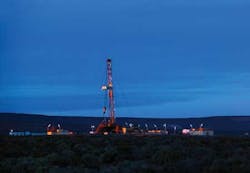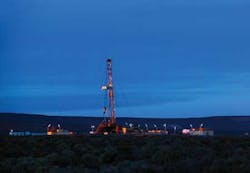Global update on shale development
Advances in the US, China, and Argentina evolve the shape of global shale markets
Nearly half of the gas produced from Apache's operations in Neuquen Basin contributes to Argentina's Gas Plus program, which targets development of "new gas" from undeveloped formations. Photo courtesy of Apache Corp.
Regina Mayor
KPMG
Houston
Drew Koecher
KPMG
Dallas
Shale is fast transforming itself from 'tomorrow's big thing' to become an essential part of the global energy sector. Although the US is still way out in front in terms of commercializing this valuable asset, other countries, China and Argentina in particular, are playing an accelerated game of catch-up, with a series of discoveries and technological advances that will undoubtedly change the landscape of global shale markets.
US
- Continued depressed gas prices have led many companies to diversify, shifting their assets towards higher growth, oil and 'wet' plays.
- Capital continues to flow into the North American market, and is increasingly allocated to the exploration and development of existing holdings, partly at the expense of M&A activity.
- With a continued positive outlook for proven unconventional reserves, an overstretched US midstream infrastructure highlights additional concerns over resource accessibility and US export policy.
- Attracted by new discoveries, access to world-leading technology and the prospect of a US industrial revival, foreign buyers, non-traditional players, large independents and majors are all poised to continue their active pursuit of North American shale gas and oil for the foreseeable future.
Issues and opportunities
Reindustrialization
The abundance of hydrocarbons in the US, along with competitively priced natural gas, has rejuvenated the outlook for the US industrial landscape, with the prospective capital investments in the gas-intensive manufacturing and chemicals sectors. It has also sparked a political and economic debate over whether to: a) move forward with some of the pending liquified natural gas (LNG) projects, and export to Asian markets where prices are higher, or b) retain a global competitive advantage in the US by allocating gas supplies to help develop domestic chemical and industrial complexes. The former would create some upward lift on prices for energy producers and bring significant LNG construction opportunities in the US, while the latter would facilitate a continued recovery in domestic manufacturing by mitigating price pressure on natural gas and refined products.
Infrastructure
In certain regions of the US, there is a lack of pipelines, terminals and storage to hold and transport shale gas and oil to the customer base. Moving these materials adds considerable costs, especially when using rail. In order to fully exploit the potential of shale gas, the sector needs billions in upstream investments for wet gas production and for dry gas.
LNG prospects
US LNG exports are forecasted to rise to around 0.18-0.24 billion cubic meters (bcm) or 6.5-8.5 billion cubic feet (bcf) by the end of the decade. A number of LNG facilities are awaiting permits, including terminals along the US coastline, where the Eastern Seaboard in particular has a solid infrastructure for export. As of June 2013 only two of the terminals proposed to the Federal Energy Regulatory Commission (FERC) have been approved to export LNG to non-FT countries. Despite the slow progress of these approvals, the US is in position to become a major exporter.
M&A trends
With dry gas prices remaining low, shale gas transactions (as a percentage of total upstream transaction value) have subsequently decreased. This has created a valuation gap, as owners are unwilling to part with gas assets at depressed valuations, while buyers are reluctant to offer more. As a result, operators and investors are devoting more time to developing existing reserves and improving production efficiency, while de-risking their asset exposure.
Many operators and investors have shifted their capital investment and asset exposure to the development of unconventionals, as well as 'wet' gas reserves. Gas producers have diverted investment to oilfields and even shut in some gas production, while 'wet' gas/oil-intensive basins such as North Dakota's Bakken and Texas' Eagle Ford basins both register high rig counts, and continue to enjoy a disproportionate share of M&A activity.
Despite the general shift in M&A towards liquids, some majors continue to increase exposure to shale gas through M&A and/or reserve development. In addition, utility providers are starting to buy into dry gas as an alternative to the spot market, entering into joint ventures with shale operators to secure their longer term supply base.
Master Limited Partnerships (MLPs) have become a popular and tax-efficient way to invest in the energy sector, with several players using this structure to exit, fully or in part, their upstream resources.
New market entrants
Over the past five years, a number of foreign NOCs have entered the market via joint ventures. The NOCs are interested in the emerging shale exploration and production technologies, hoping to accelerate their learning to exploit China's domestic shale opportunities.
Outlook
Longer term prospects for shale are undeniable. LNG faces an uncertain future; nevertheless, the US has undoubted potential to export on a large scale.
The trend for foreign energy companies, non-traditional players, large independents and majors to invest in North American shale gas and oil looks set to continue, fueled by the US's industrial rejuvenation and the opportunity to tap into the existing technology and intellectual property.
China
Although the Chinese market has yet to break through to the commercialization phase, the government has ambitious targets for shale output by 2015.
As a sign of its commitment to shale, the Chinese government is offering subsidies for development.
European and US players are moving into the market in a series of joint ventures, with China's shale exploration and development looking to benefit from new joint venture partners' expertise and experience.
According to Chinese government figures, over US$1.13 billion has been invested in exploring the country's shale prospects up to the end of 2012. Output to date is just 0.015bcm of shale gas, which pales against the official target of 6.5bcm per year by the end of 2015.
More drilling permits have been awarded in 2013, and hopes are pinned on the glut of joint ventures with foreign partners, such as PetroChina's production-sharing contract with Shell that was approved in March 2013, the first of its kind. In addition, a shale gas subsidy is available for shale extracted up to 2015. This is further evidence of the Chinese government's commitment to shale gas and oil, which are both considered to be 'encouraged foreign investment industries' within China limited to equity joint ventures and contractual joint ventures.
Despite large reserves, China faces significant obstacles in recovering and commercializing shale gas and oil. The country's severe water shortages may hinder an industry that is highly dependent upon very large volumes of water. The existing pipeline infrastructure is also insufficient to transport gas to the main centers of population, which can be thousands of miles from the source. However, China's lack of fracking technology could prove to be the greatest hurdle to overcome.
The Chinese shale market has considerable potential, assuming it can overcome challenges. The growing investment by Chinese companies in the US is evidence of a thirst for acquiring essential fracking know-how. Government financial subsidies should help the drive towards commercialization, aided by the growing participation of US and European energy companies via joint ventures.
Argentina
- Argentina's significant potential is being held back to some extent by fears over the political and regulatory environment.
- Substantial infrastructure developments are helping to expand opportunities for both domestic consumption and export.
Argentina has some of the world's biggest and best-quality reserves of shale hydrocarbons. The 2012 discovery of shale gas in the Vaca Muerta formation in Argentina's Neuquén Province is further confirmation of the country's newfound promise of gas self-sufficiency.
Shale gas projects in Argentina are following a similar pattern to other regions, with a number of joint ventures involving Argentina's state-run energy company Yacimientos Petrolíferos Fiscales (YPF). Although foreign investors are excited about the prospects in Argentina, they are sizing up the political and economic environment before committing significant funds, with concerns over a recession and possible resource nationalism. Regulatory and technical issues aside, large-scale commercialization of shale appears inevitable, given Argentina's huge reserves, excellent geology and strong oil and gas industry.
Conclusion
The continued impact of shale dry gas upon global prices will in part be determined by the degree to which it is exported as LNG; some governments may choose to put pressure on their energy industries to retain this critical resource to provide much-needed self-sufficiency. This factor, along with the speed of recovery of the US industry, may have a significant impact upon the return on investments in dry shale gas.
About the authors
Regina Mayor is the National Advisory Energy Sector Leader for KPMG LLP, the US audit, tax and advisory firm. She specializes in business performance improvement and has significant experience delivering large scale business and technology changes to major oil companies around the world.
Drew Koecher is KPMG's Energy Sector Leader for Transaction Services and Restructuring and has over 20 years' experience directing global and domestic mergers & acquisitions, restructuring and integration services for clients.
The views and opinions expressed herein are those of the authors and do not necessarily represent the views and opinions of KPMG LLP.




